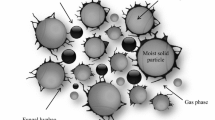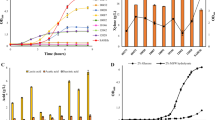Abstract
This study demonstrated the potential for managing starch processing waste (SPW) by bioconversion to Cordyceps militaris mycelia using solid state cultivation (SSC) and submerged liquid cultivation (SLC). The growth characteristics of C. militaris mycelium were accessed and compared for SSC and SLC systems on SPW under various conditions of initial SPW concentration, pH, and operating temperature. To quantify the mycelial biomass in SLC, original primer sets targeting the 18S rRNA gene of C. militaris were developed. In SSC, a maximum mycelial growth rate (543.1 mm2/day) was predicted to occur at 25.6 g SPW/L, pH 5.5, and 23.8 °C. In SLC, a maximum mycelial growth rate (1918.6 mg/L/day) was predicted to occur at 35.5 g SPW/L, pH 5.5, and 22.0 °C. Temperature was suggested as the most significant factor in both systems. The higher optimum substrate concentration observed for SLC than for SSC was likely due to difference in mycelial morphology and mixing effect.




Similar content being viewed by others
References
APHA-AWWA-WEF (2005). Standard methods for the examination of water and wastewater (21st ed.). Washinton, DC: American Public Health Association.
Barrios-González, J. (2012). Solid-state fermentation: physiology of solid medium, its molecular basis and applications. Process Biochemistry, 47, 175–185.
Cui, J. D. (2015). Biotechnological production and applications of Cordyceps militaris, a valued traditional Chinese medicine. Critical Reviews in Biotechnology, 35, 475–484.
Das, S. K., Masuda, M., Sakurai, A., & Sakakibara, M. (2010). Medicinal uses of the mushroom Cordyceps militaris: current state and prospects. Fitoterapia, 81, 961–968.
Driouch, H., Roth, A., Dersch, P., & Wittmann, C. (2011). Filamentous fungi in good shape: microparticles for tailor-made fungal morphology and enhanced enzyme production. Bioengineered Bugs, 2, 100–104.
DuBois, M., Gilles, K. A., Hamilton, J. K., Rebers, P. A., & Smith, F. (1956). Colorimetric method for determination of sugars and related substances. Analytical Chemistry, 28, 350–356.
Eckhoff, S. R., Singh, S. K., Zehr, B. E., Rausch, K. D., Fox, E. J., Mistry, A. K., et al. (1996). A 100-g laboratory corn wet-milling procedure. Cereal Chemistry, 73, 54–57.
Gao, D., Zeng, J., Yu, X., Dong, T., & Chen, S. (2014). Improved lipid accumulation by morphology engineering of oleaginous fungus Mortierella isabellina. Biotechnology and Bioengineering, 111, 1758–1766.
Goñi, I., Garcia-Alonso, A., & Saura-Calixto, F. (1997). A starch hydrolysis procedure to estimate glycemic index. Nutrition Research, 17, 427–437.
Grimm, L. H., Kelly, S., Krull, R., & Hempel, D. C. (2005). Morphology and productivity of filamentous fungi. Applied Microbiology and Biotechnology, 69, 375–384.
Haldane, F. D. M. (1983). Continuum dynamics of the 1-D Heisenberg antiferromagnet: identification with the O(3) nonlinear sigma model. Physics Letters A, 93, 464–468.
Holker, U., & Lenz, J. (2005). Solid-state fermentation—are there any biotechnological advantages? Current Opinion in Microbiology, 8, 301–306.
Inglet, B. S., Song, M., Hansen, C. L., & Hwang, S. (2006). Short communication: cultivation of Lentinus edodes mycelia using whey permeate as an alternative growth substrate. Journal of Dairy Science, 89, 1113–1115.
Jasti, N., Khanal, S. K., Pometto 3rd, A. L., & van Leeuwen, J. H. (2008). Converting corn wet-milling effluent into high-value fungal biomass in a biofilm reactor. Biotechnology and Bioengineering, 101, 1223–1233.
Jin, B., van Leeuwen, H. J., Patel, B., & Yu, Q. (1998). Utilisation of starch processing wastewater for production of microbial biomass protein and fungal α-amylase by Aspergillus oryzae. Bioresource Technology, 66, 201–206.
Kang, C., Wen, T. C., Kang, J. C., Meng, Z. B., Li, G. R., & Hyde, K. D. (2014). Optimization of large-scale culture conditions for the production of cordycepin with Cordyceps militaris by liquid static culture. TheScientificWorldJOURNAL, 2014, 510627.
Kim, H. O., & Yun, J. W. (2005). A comparative study on the production of exopolysaccharides between two entomopathogenic fungi Cordyceps militaris and Cordyceps sinensis in submerged mycelial cultures. Journal of Applied Microbiology, 99, 728–738.
Kim, S. W., Hwang, H. J., Xu, C. P., Sung, J. M., Choi, J. W., & Yun, J. W. (2003). Optimization of submerged culture process for the production of mycelial biomass and exo-polysaccharides by Cordyceps militaris C738. Journal of Applied Microbiology, 94, 120–126.
Krull, R., Wucherpfennig, T., Esfandabadi, M. E., Walisko, R., Melzer, G., Hempel, D. C., et al. (2013). Characterization and control of fungal morphology for improved production performance in biotechnology. Journal of Biotechnology, 163, 112–123.
Lee, B. C., Bae, J. T., Pyo, H. B., Choe, T. B., Kim, S. W., Hwang, H. J., et al. (2004). Submerged culture conditions for the production of mycelial biomass and exopolysaccharides by the edible Basidiomycete Grifola frondosa. Enzyme and Microbial Technology, 35, 369–376.
Lee, C., Lee, S., Cho, K. J., & Hwang, S. (2011). Mycelial cultivation of Phellinus linteus using cheese-processing waste and optimization of bioconversion conditions. Biodegradation, 22, 103–110.
Lee, S., Bae, H., Kim, N., & Hwang, S. (2008). Optimization of growth conditions of Lentinus edodes mycelium on corn processing waste using response surface analysis. Journal of Bioscience and Bioengineering, 105, 161–163.
Lu, N., Zhou, S.-g., Zhuang, L., Zhang, J.-t., & Ni, J.-r. (2009). Electricity generation from starch processing wastewater using microbial fuel cell technology. Biochemical Engineering Journal, 43, 246–251.
Mani, A., Patel, J., Kalam, S., Singh, R. and Sandhu, S. S. (2015) Evaluation of mycelial and exo-polysaccharide production from Cordyceps militaris. International Journal of Applied Sciences and Engineering Research, 4, 609–619.
Mao, X. B., Eksriwong, T., Chauvatcharin, S., & Zhong, J. J. (2005). Optimization of carbon source and carbon/nitrogen ratio for cordycepin production by submerged cultivation of medicinal mushroom Cordyceps militaris. Process Biochemistry, 40, 1667–1672.
Mitchell, D. A., Berovic, M., & Krieger, N. (2000). New Products and New Areas of Bioprocess Engineering (pp. pp. 61–pp.138). Berlin, Heidelberg: Springer Berlin Heidelberg.
Montgomery, D. C. (2008) Design and analysis of experiments. ed. John Wiley & Sons.
Muniraj, I. K., Xiao, L., Liu, H., & Zhan, X. (2015). Utilisation of potato processing wastewater for microbial lipids and γ-linolenic acid production by oleaginous fungi. Journal of the Science of Food and Agriculture, 95, 3084–3090.
Pandey, A. (2003). Solid-state fermentation. Biochemical Engineering Journal, 13, 81–84.
Papagianni, M. (2004). Fungal morphology and metabolite production in submerged mycelial processes. Biotechnology Advances, 22, 189–259.
Papagianni, M. (2014). Characterization of fungal morphology using digital image analysis techniques. J Microb Biochem Technol, 6, 189–194.
Park, J. P., Kim, S. W., Hwang, H. J., & Yun, J. W. (2001). Optimization of submerged culture conditions for the mycelial growth and exo-biopolymer production by Cordyceps militaris. Letters in Applied Microbiology, 33, 76–81.
Pathania, P., & Sagar, A. (2014). Studies on the biology of Cordyceps militaris: a medicinal mushroom from northwest Himalaya. KAVAKA, 43, 35–40.
Purwanto, L., Ibrahim, D., & Sudrajat, H. (2009). Effect of agitation speed on morphological changes in Aspergillus Niger hyphae during production of tannase. World Journal Chemistry, 4, 34–38.
Raghavarao, K. S. M. S., Ranganathan, T. V., & Karanth, N. G. (2003). Some engineering aspects of solid-state fermentation. Biochemical Engineering Journal, 13, 127–135.
Rahardjo, Y. S. P., Tramper, J., & Rinzema, A. (2006). Modeling conversion and transport phenomena in solid-state fermentation: a review and perspectives. Biotechnology Advances, 24, 161–179.
Shi, X.-M., Liu, H.-J., Zhang, X.-W., & Chen, F. (1999). Production of biomass and lutein by chlorella protothecoides at various glucose concentrations in heterotrophic cultures. Process Biochemistry, 34, 341–347.
Shih, I. L., Tsai, K. L., & Hsieh, C. (2007). Effects of culture conditions on the mycelial growth and bioactive metabolite production in submerged culture of Cordyceps militaris. Biochemical Engineering Journal, 33, 193–201.
Shrestha, B., Zhang, W. M., Zhang, Y. J., & Liu, X. Z. (2012). The medicinal fungus Cordyceps militaris: research and development. Mycol Progress, 11, 599–614.
Tang, Y. J., Zhu, L. W., Li, H. M., & Li, D. S. (2007). Submerged culture of mushrooms in bioreactors—challenges, current state-of-the-art, and future prospects. Food Technol Biotech, 45, 221–229.
te Biesebeke, R., Ruijter, G., Rahardjo, Y. S., Hoogschagen, M. J., Heerikhuisen, M., Levin, A., et al. (2002). Aspergillus oryzae in solid-state and submerged fermentations. Progress report on a multi-disciplinary project. FEMS Yeast Research, 2, 245–248.
Whistler, R. L. and Daniel, J. R. (1978) Starch. ed. Wiley Online Library.
Won, S. Y., & Park, E. H. (2005). Anti-inflammatory and related pharmacological activities of cultured mycelia and fruiting bodies of Cordyceps militaris. Journal of Ethnopharmacology, 96, 555–561.
Yamada, Y., Makimura, K., Merhendi, H., Ueda, K., Nishiyama, Y., Yamaguchi, H., et al. (2002). Comparison of different methods for extraction of mitochondrial DNA from human pathogenic yeasts. Japanese Journal of Infectious Diseases, 55, 122–125.
Yang, B. K., Ha, J. Y., Jeong, S. C., Das, S., Yun, J. W., Lee, Y. S., et al. (2000). Production of exo-polymers by submerged mycelial culture of Cordyceps militaris and its hypolipidemic effect. Journal of Microbiology and Biotechnology, 10, 784–788.
Yu, Y., Lee, C., Kim, J., & Hwang, S. (2005). Group-specific primer and probe sets to detect methanogenic communities using quantitative real-time polymerase chain reaction. Biotechnology and Bioengineering, 89, 670–679.
Zhong, J.-J. and Tang, Y.-J. (2004), in Biomanufacturing, vol. 87: Advances in Biochemical Engineering, (Zhong, J.-J., ed.), Springer Berlin Heidelberg, pp. 25–59.
Zhou, X., Gong, Z., Su, Y., Lin, J., & Tang, K. (2009). Cordyceps fungi: natural products, pharmacological functions and developmental products. The Journal of Pharmacy and Pharmacology, 61, 279–291.
Acknowledgments
This work was financially supported by Korea Ministry of Environment as “Knowledge-based environmental service (Waste to energy recycling) Human resource development Project.” This work was also supported by “Human Resources Program in Energy Technology” of the Korea Institute of Energy Technology Evaluation and Planning (KETEP) Grant, funded by the Ministry of Trade, Industry and Energy, Republic of Korea (No. 20144030200460).
Author information
Authors and Affiliations
Corresponding author
Rights and permissions
About this article
Cite this article
Lee, J., Cho, K., Shin, S.G. et al. Nutrient Recovery of Starch Processing Waste to Cordyceps militaris: Solid State Cultivation and Submerged Liquid Cultivation. Appl Biochem Biotechnol 180, 274–288 (2016). https://doi.org/10.1007/s12010-016-2098-4
Received:
Accepted:
Published:
Issue Date:
DOI: https://doi.org/10.1007/s12010-016-2098-4




